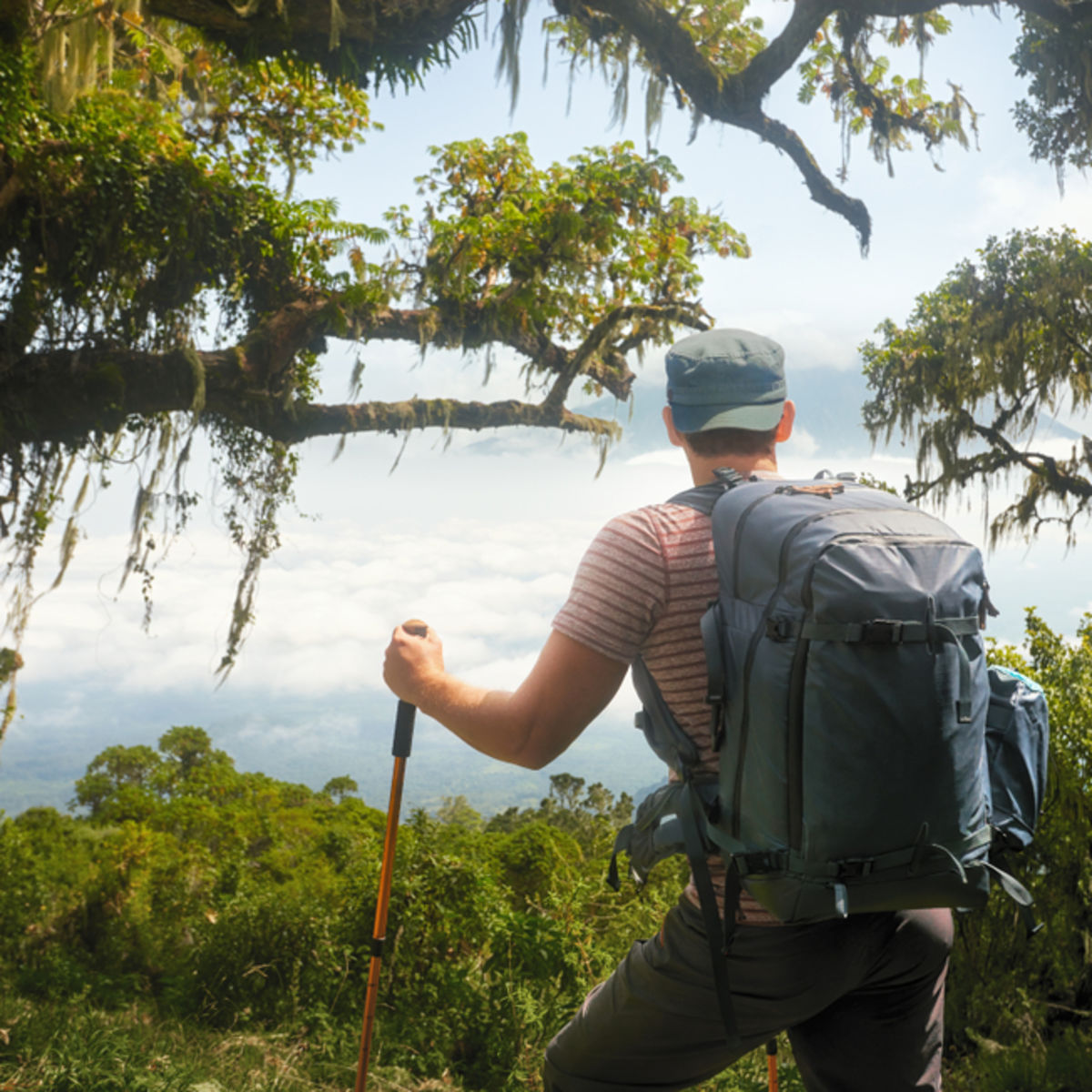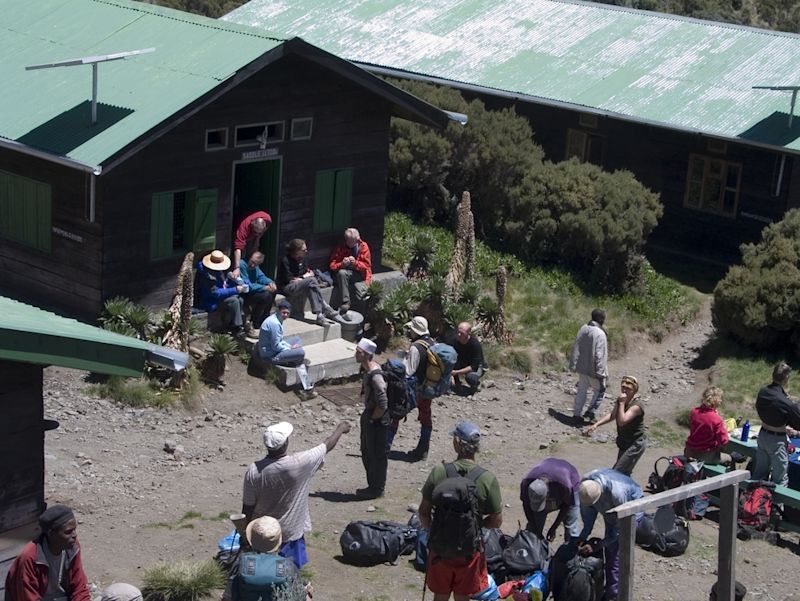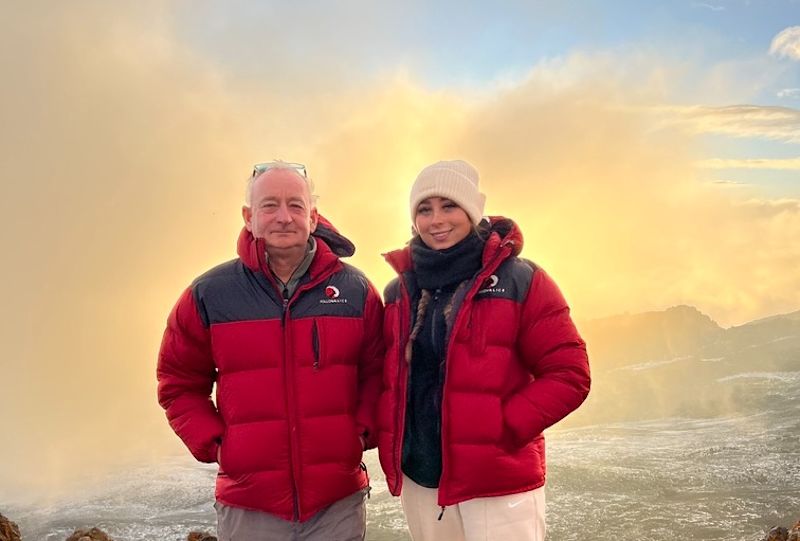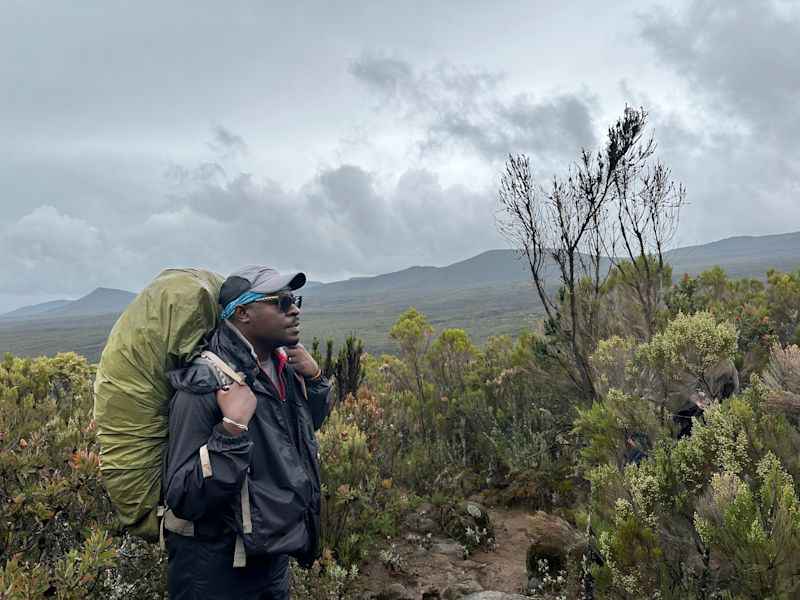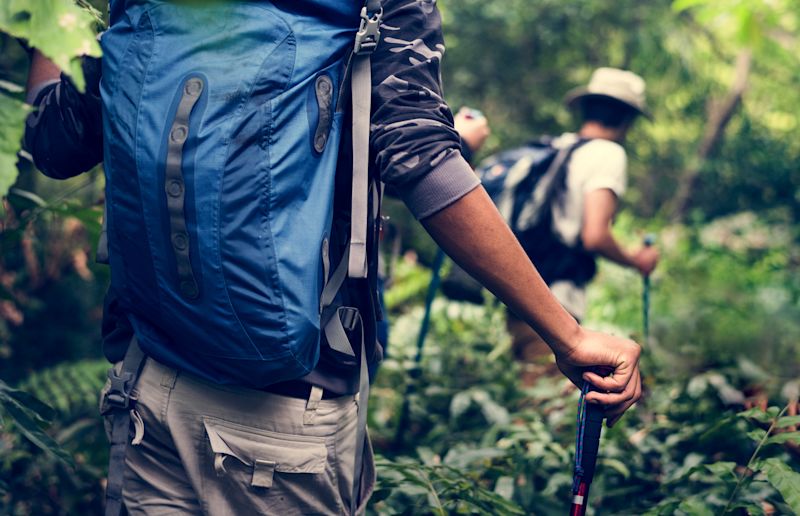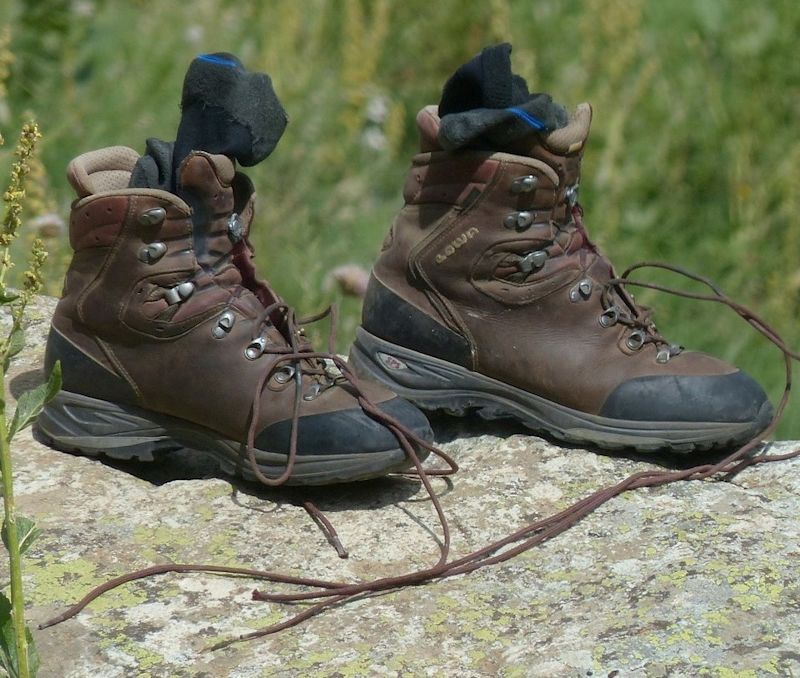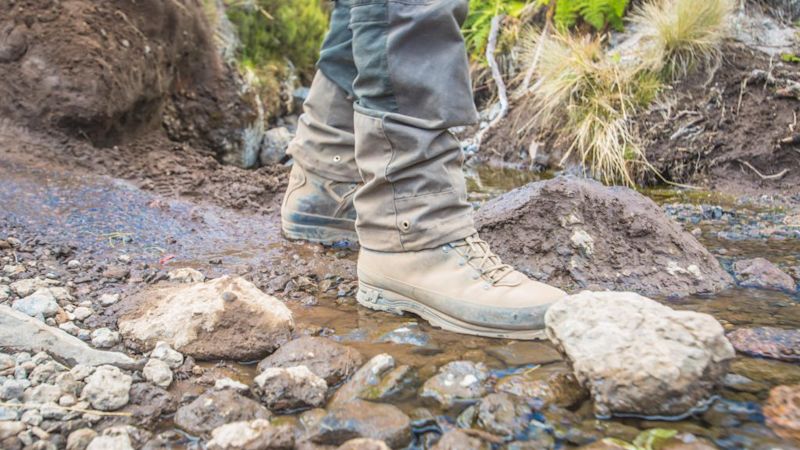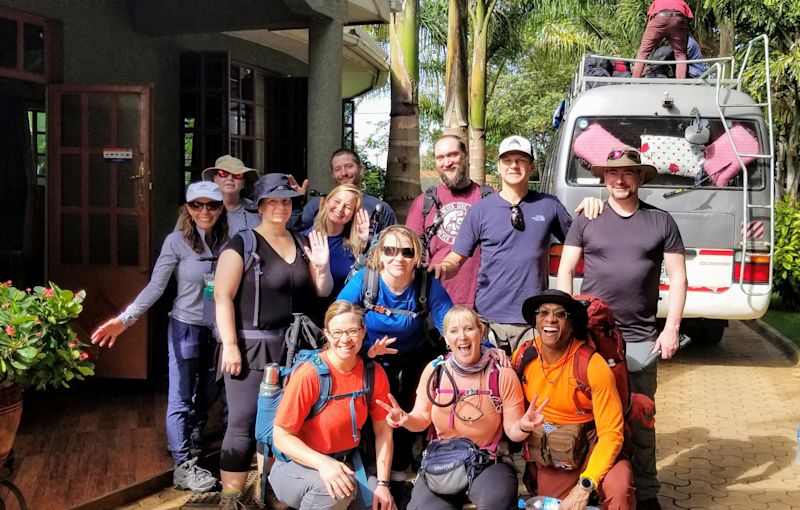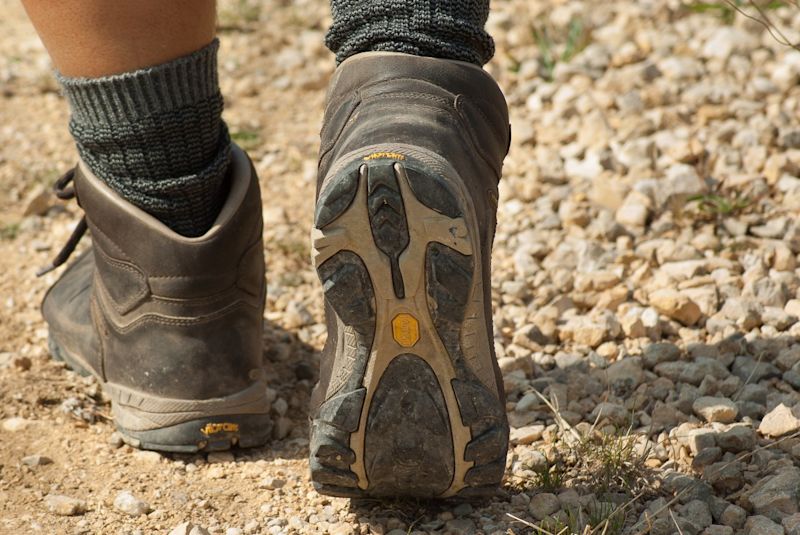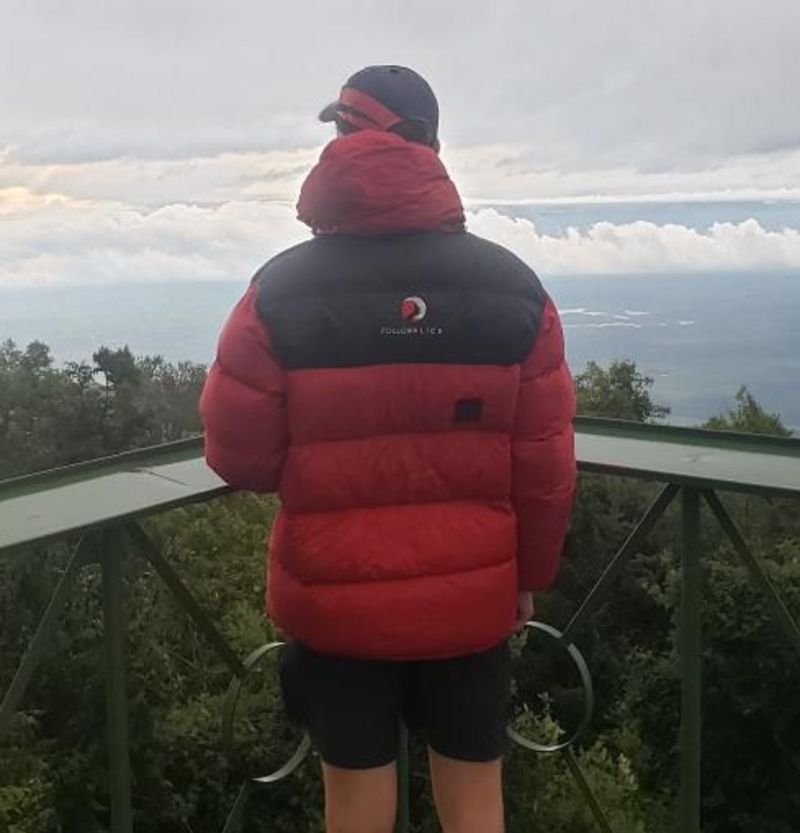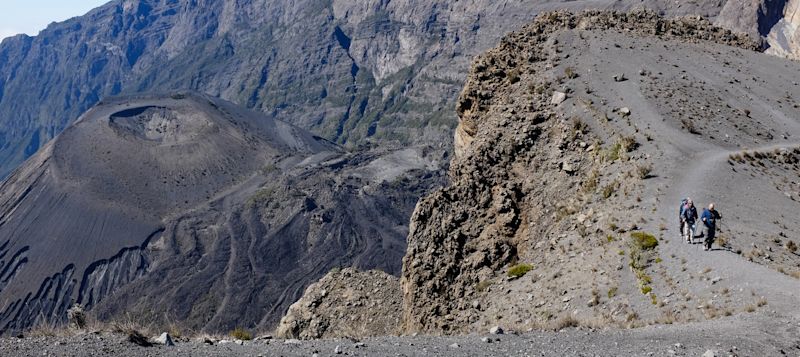This blog post contains a complete Mt Meru packing list to help you plan and prepare for this epic adventure!
Please read through this packing list as soon as you decide to climb Mt Meru – some items might take time to source, while others need to be broken in or trial tested before the climb.
Let's by briefly looking at what items are provided at the mountain huts, and what Follow Alice will loan or can rent to you if you choose.
We'll then get into the meat of the post, which is discussing everything you need to pack yourself, from hiking gear like a backpack and trekking poles to clothes, shoes, toiletries, first aid items, gadgets and more.
What's provided at the mountain huts
You stay in communal huts on a Mt Meru climb, so your packing list is a little shorter than it would be if you were climbing Mt Kilimanjaro, where most people camp. Notably, the huts have dormitory-style bedrooms, each of which is equipped with bunk beds, mattresses, pillows and duvets (though a sleeping bag is still essential).
You stay in communal huts on a Mt Meru climb
What's provided by Follow Alice
Ultimately, we want to keep you warm, safe and healthy during your climb! In fact, we feel so strongly about this that we provide you with one of our winter sleeping bags to use during the climb at no extra cost!
We also provide clients with winter jackets and trekking poles if you wish for a small rental fee.
Two of our lovely clients in their Follow Alice jackets
Our winter jackets are made from down and can withstand temperatures as low as -20°C (-4°F). These red-and-black branded jackets can be rented for US$65 for the duration of the climb. We highly recommend these to ensure you stay warm enough!
We can also rent you high-quality, collapsible trekking poles for US$20 for the trip. Trekking poles are invaluable on a climb like Meru as they offer extra balance and help to protect your knees on the long descent.
What YOU need to pack
Let's now look at what you need to bring along for a safe and comfortable Mt Meru climb ...
1. Carrying equipment
You need to bring the following carrying equipment to Mt Meru:
- A backpack (between 35 and 50 litres)
- A backpack rain cover
- Dry bags
- A duffel bag (between 65 and 100 litres)
- A hydration pack (water bladder)
- A water bottle
Here's a little more detail on each of the above important items ...
Backpack
This is the bag that you carry on your back while on each day's hike. All the items that you might need during the day go into this bag, including your snacks, drinking water, camera and extra layers of clothing.
It's important you make an educated decision as to what backpack to bring. Really good, quality backpacks have an internal frame. They also have padded shoulder and hip straps, as well as sternum straps.
You should also look for a pack with a suspended mesh back, as this allows your body heat to escape. This is something that's especially important on those warmer days lower down the mountain.
Ideally, you want a backpack with a large (2 to 3ℓ) built-in hydration pack that allows you to drink from a hose.
Some backpacks also come with their own fitted rain cover, which is useful.
Further, if you intend to bring along trekking poles, see if there are hooks for attaching these to the exterior when you want your hands to be free.
Learn more: How to choose to a backpack for high-altitude trekking.
Do training hikes with your backpack
As we discuss in How should I train for Kilimanjaro? (which is a similar adventure to Meru, just a little shorter and easier), you should do some training hikes using your backpack. In this way you can ensure the backpack is comfortable.
On these training hikes, we recommend that you also carry all the water and other items that will go into it on your Mt Meru climb to get used to the weight.
Backpack rain cover
We highly recommend you pack a rain cover that's fitted to your backpack, even if your backpack is water-resistant. Nobody needs the added challenge of carrying a sopping, heavy backpack when tackling a mountain like Mt Meru.
Many outdoor backpacks come with a built-in rain cover. This is really useful, as you stand no chance of forgetting it! It's also perfectly sized to your backpack.
Our very own Bobu sporting a nicely fitting backpack rain cover
Dry bags
In an attempt to reduce pollution, the Government of Tanzanian has prohibited any plastic carrier bags from entering the country. You're therefore advised to avoid having plastic carrier bags in any of your luggage.
You're not allowed to bring single-use plastic bags into Tanzania.
While your backpack rain cover should keep the contents of your bag dry, it's a good idea to also bring along some dry bags. These are useful for:
- Protecting clothes in case there's a leak in your bag
- Storing worn, sweaty clothes
Duffel bag
Your duffel bag – or any other soft bag – contains everything else you need for the climb, including your sleeping bag. If you simply cannot fit your sleeping bag into your duffel bag, our team will strap it onto the outside of the duffel bag for you.
Your duffel bag is carried by one of the porters in your mountain crew and should weigh under 14 kg (31 lb).
Please don't bring a stiff bag like a suitcase, or anything too precious, as it could get a bit squished when carried by the porter. It's also not as comfortable or easy for the porters to carry.
Your backpack is needed just for storing your stuff for that day's hike
Ensure at the start of every day that you've put what you might need for that day's climate in your backpack. You'll also carry your own water and food. Everything else must fit into your duffel bag.
2. Water carriers
When packing for Mt Meru we recommend you include the following water carriers:
- A built-in hydration pack with drinking hose
- Two or more one-litre water bottles with secure lids
We cannot over-stress how important it is to have enough water to drink while on your climb. Not only are you being very active and so need to hydrate, but water also helps to ease the symptoms of altitude sickness.
Every trekker should carry two to three litres of water per day.
Hydration pack
Most hiking backpacks have capacity for a hydration bag (also called a water bladder). Some even have a built-in hydration pack. A well-known brand of hydration packs is the CamelBak.
Built-in water bladders with drinking hoses are really useful
Hydration packs come with a drinking hose attached, which is really great. This means that instead of reaching for a water bottle when thirsty, you can just pick up the mouthpiece and drink from there.
You should take sips of water often on your Mt Meru climb – if you're thirsty, then you're already dehydrated!
Water bottle
We recommend that you also carry a full water bottle (or two). We have three reasons for saying this:
- It's a good idea to carry more water than what a standard hydration pack can carry on summit day.
- A water bottle is important backup should something go wrong with your hydration pack.
- It can be nice to add an electrolyte sachet to a bottle of water while keeping your hydration pack full of plain water.
- The water in your hydration pack's drinking hose is likely to freeze if the temperature drops below freeing point.
It takes a whole lot of effort and sweat to reach Mt Meru's Socialist Peak!
It's best to keep your water bottle as close to your body on summit day as possible to prevent the water from freezing – in this way, you can sip from here if the water in your hydration pack's drinking hose is frozen. Putting your water bottle inside a thermal sock also helps to keep it from freezing.
Ensure your water bottle is good quality and the lid closes securely. A leak won't be welcomed.
Also, note that water freezes from top to bottom, so if you carry your water bottle upside down then you can still drink from it even if the top part has started to freeze.
You should pack the following footwear for Mt Meru:
- Hiking boots
- Gym shoes or sneakers
- Gaiters (optional)
Hiking boots
The most important item on your Mt Meru packing list is a pair of comfortable, worn in hiking boots.
We recommend opting for either leather or synthetic trekking boots. Leather boots that are properly looked after last longer than any other type of boot.
Please read The best hiking boots for Kilimanjaro to learn more about the type of trekking boots to look for, as the conditions for climbing Mt Meru are pretty much the same as those for Kilimanjaro!
Ideally, you should hike around 100 km in your trekking boots before the two of you head to Mt Meru.
We also want to stress the importance of either wearing your boots or having them in your hand luggage on your travels to Tanzania. Should your luggage disappear, you want to at least have your essential items on you. We always do our best to help clients with any needed items, but new or borrowed hiking boots can compromise your climb.
Gym shoes or sneakers
After a long day of hiking, the thought of sitting back and kicking off your boots is pure bliss. This is great except for the fact that the temperature can plummet higher up on the mountain.
So when you're packing for Mt Meru, it's a good idea to throw in a pair of comfortable, closed sneakers to wear around camp.
Gaiters
Gaiters aren't essential, but we do recommend using them.
Gaiters are helpful in:
- Keeping your calves and feet dry
- Preventing sticks and stones getting into your shoes (super annoying!)
- Protecting you from ticks, snakebites and other such nasties
- Keeping you dry should you walk through snow on summit day
Things can get muddy on a Mt Meru climb
4. Inner clothing
We recommend you pack the following inner layers of clothing:
- Base layers
- Summit base layer
- Fleece
- Sports underwear
- Thermal underwear
- Socks
Climbing Mt Meru means hiking through rainforest, moorland and alpine desert. For this reason, it's helpful to have quite a few layers to work with.
Base layers
Your base layer is the layer that sits closest to your body and helps to regulate your body temperature. You don't want a fabric that take a long time to dry (like cotton), as this will chill you when you stop exercising.
On the natural side of things, merino wool or bamboo works really well. Both are breathable and so moisture escapes easily.
Alternatively, choose a synthetic material – or one that's a combination of natural and synthetic fibres – that has really excellent sweat-wicking properties. Good options include nylon, polyester, polypropylene and MicroModal.
Summit base layer
Your summit base layer should include long johns and a thermal, long-sleeved vest (preferably made of merino wool) that you wear for summit day only.
Your summit day climb is by far the longest hike of the entire Mt Meru climb. So having a fresh and comfortable layer for this day's hike is ideal.
Fleece
Your middle layer is for your torso and is worn over your base layer. This garment should be comfortable and easy to move in. We recommend a thin fleece or parka for this layer.
Underwear
So it goes without saying that a fresh set of underwear is always a pretty good way to start each day! That's why we recommend that you bring multiple pairs along with you.
It's best to wear sports pants (and bras) on Mt Meru, as they're comfortable and breathable. Again, avoid cotton. You want fabrics that wick away sweat.
Thermal underwear
The climate is very cold near the top of Mt Meru, so you need to pack thermal underwear. We recommend having two of each item – one of which you keep especially for summit day, the coldest and longest day of all.
Socks
Just like underwear, we suggest that you bring a few pairs of socks along with you for your Mt Meru adventure. And we advise that you bring three different types of sock:
- Hiking socks
- Thermal socks
- Sock liners
First and foremost, you must pack some regular hiking socks. We advise that you test out your hiking socks before coming to Mt Meru. Use them when breaking in your hiking boots. This way you'll be able to detect any troublesome seams or the like.
Your socks should always be higher than the cuff of your boots
We're sure you've noticed a trend by now: have a fresh 'everything' that you save for summit day. This certainly goes for your hiking socks. Only note that your summit day socks should be thermal socks, as you need the extra warmth to avoid cold feet.
We also suggest you wear sock liners. Not everyone does, but these are great in helping to prevent blisters because the friction gathers between the liner and the sock rather than between your skin and the sock. It's quite common for climbers to get blisters on their feet, especially on summit day when you're on your feet for several hours.
If you want to know more about avoiding and dealing with blisters, please read How to prevent (and treat) foot blisters when trekking.
5. Outer clothing
You need to pack the following outer layers for your Kilimanjaro climb:
- Winter jacket
- Waterproof jacket and trousers
- Hiking trousers
Winter jacket
A good-quality winter jacket is a very important item on your Mt Meru packing list. Down is a good insulating material, which is why the Follow Alice winter jackets that we rent to clients are made with down. (Please note that our down jackets are not waterproof.)
Our client Alex in his cosy Follow Alice jacket on Mt Meru
You can either bring a winter jacket of your own, or rent one from Follow Alice for US$65 for the trip.
The start of the climb is relatively warm and humid, so your winter jacket won't be needed and can be kept in your duffel bag. From then on you'll keep it in your backpack so that you can haul it out whenever you want it.
A winter jacket is essential for summit day
You're likely to start wearing your winter jacket when you reach the moorland zone. You'll certainly be wrapping up in it in the alpine desert zone! It's also your favourite item in the evenings.
Waterproof jacket and trousers
Waterproof garments are essential for the start of your hike, especially if you climb Mt Meru during the rainy season. (Learn more in The best time to climb Mt Meru.)
That said, it's smart to carry waterproof gear no matter what time of year you climb.
While regular rain gear is waterproof, it generally isn't very breathable. Given how much you sweat when hiking, it's important to have a rain jacket and trousers that are relatively lightweight and have inner membranes to make them breathable. We recommend bringing a waterproof jacket that has a 2,000 hydrostatic head (this tells you how waterproof the jacket is).
Of course, you could opt for a poncho instead of a rain jacket. This has the benefit of being able to fit over your backpack as well, eliminating the need for a special backpack rain cover. The drawback, however, is that it can obscure your view at times of where exactly you're putting your feet.
A windbreaker also goes a long way on Mt Meru. There's nothing worse than wearing multiple layers to keep warm and the wind still cuts right through. To keep the load light, we suggest looking for a waterproof jacket that is also a windbreaker. We love a two-in-one solution!
Also, jackets with elasticated wristbands are helpful in keeping out the cold and wind.
Hiking trousers
Pack at least one pair of durable, breathable and comfortable trousers. Two pairs is enough, really, as you can swap them out if one needs some drying or airing.
We love convertible (zip-off) trousers that you can turn into shorts on warm days. Again with the two-in-one winning formula! Obviously you could choose instead to pack regular hiking trousers as well as a pair of shorts.
Some people like to wear trousers no matter the temperature as they protect your legs from sunburn, insect bites and scratches. Long trousers also help to prevent dirt and pebbles finding their way into your boots.
6. Accessories
Some important accessories to pack for a Mt Meru climb are:
- Sunhat
- Warm hat
- Balaclava or snood
- Head torch (flashlight) and batteries
- Gloves or mittens
- Glove inners
- Sunglasses
Sunhat
A sunhat is important for the beginning and end of the adventure when you're lower down on the mountain.
The heat of the sun can be very intense in Tanzania – remember that you're near the Equator!
A sunhat is better than a cap to protect the back of your neck.
The odd person might also like to bring a headband so that sweat doesn't run into your eyes.
Warm hat
As you climb higher, you need a warm hat like a beanie. A beanie can also be worn when you sleep to avoid heat escaping through your head.
On summit day you're grateful for every warm item you packed!
Balaclava or snood
We suggest you bring a thermal balaclava for summit day as this helps to keep your head, ears and neck warm.
Alternatively, consider a scarf or, even better, a thick snood, as this stands no chance of slipping off or flapping annoyingly.
Head torch (flashlight)and batteries
The huts have solar electricity, but it's a good idea to have a head torch (flashlight) for backup.
The main reason, however, for a head torch is that summit day begins around 2 am in the morning! So you'll need a torch to see your way (unless there's a full moon).
Gloves or mittens
You absolutely must pack winter gloves (or ski gloves) to keep your hands warm! We especially like mittens for summit day as having all your fingers together generates more warmth.
Having said that, mittens do make it quite challenging to take pictures. So if you'd prefer fingered gloves, do ensure they're a quality pair that offer proper insulation.
Glove inners
For summit day, one pair of gloves simply isn't enough. Some glove liners, or glove inners, will help to ensure your hands and fingers don't become icicles. Fleece glove inners are nicely cosy.
Sunglasses
Polarised sunglasses or ski glasses are essential for a Mt Meru climb.
Ideally bring glasses that strike a balance between being as large as possible to fully shield your eyes, while not being too large that they fog up when you get sweaty. Wrap-around sunglasses are good for sitting snugly and keeping the sun from sneaking in at the sides.
On clear days the glare can be intense, so pack your sunnies!
Like everything else on this list, trying our sunglasses out on a trial hike will let you know beforehand if you're coming with appropriate eyewear or not.
You might also like to pack a sunglasses cord if you have one of those noses that likes to ditch glasses at the slightest opportunity. Or you could even bring ski glasses.
7. Toiletries and first aid kit
We recommend you pack the following personal items for your Mt Meru climb:
| Item | Details |
|---|
Toilet roll | Always have your own roll to hand |
Face mask or nose plug | The toilets are long drops and can get really whiffy! |
Disinfecting wet wipes | There's no running water for handwashing |
Tissues | The alpine desert zone can be dusty |
Toothbrush | Because otherwise, ewww |
Eco toothpaste | So that you don't pollute the environment |
Cleansing wet wipes | You can't shower on the mountain |
Face cloth and small soap in soap box | For 'washy washy'* |
A small microfibre towel | Microfibre towels are lightweight and dry quickly |
SPF lip balm | Your lips take a beating at high altitude and need extra UV protection |
Small moisturiser | The air is very dry high up the mountain |
Quality broad-spectrum sunscreen | UV rays are more intense at altitude |
Eye drops | The dryness of the air at altitude can irritate eyes |
Regular plasters and antiseptic cream | In case you get any cuts |
Blister plasters | For dealing with developing blisters |
Hypodermic needle and zinc oxide sports tape | In case you need to pop and dress a blister |
Insect repellent | This is needed in the rainforest zone |
Altitude meds (like Diamox) | Speak to your doctor about this |
Malaria tablets | Tanzania is in a malaria zone |
Diarrhoea tablets | High altitude can cause diarrhoea |
Painkillers | High altitude can cause headaches |
* Your mountain crew will give you a bowl of water at camp for some strategic splashing and cleaning.
Think carefully about what to include in a small, personal first aid kit. And even better, speak to your GP beforehand for advice on the matter.👩🏽⚕️
Toiletries for women
When you're at camp, you'll be able to use the toilets. But a female urinating device like a Shewee is very useful when on the trail as it lets you pee while standing. And when that happens, a pee cloth, like a Kula Cloth, is an hygienic and environmentally friendly way to avoid the drip-dry method!
A female urinating device lets you pee while standing
Important: pack your menstrual cycle products, no matter the time of month, as high altitude can bring on your period unexpectedly.
8. Technology
Some of the tech gear to consider packing for your Mt Meru climb is as follows:
- Camera
- Cellphone
- (Solar) power bank
- Small binoculars
There's limited cellphone reception on Mt Meru, but you can get reception at times. At present there's no WiFi on the mountain.
Bring along your camera – big or small – to capture the sights and special moments of the climb
9. Practical items
To travel to Tanzania you also need the following:
Please don't forget your passport! We can help with replacing pretty much anything if needed, but sadly we can't replace your passport. Make it number one on your Kilimanjaro packing list. And please ensure your passport is valid for six months after your arrival date in Tanzania.
You also need a Tanzanian visa. US, Canadian, British and most European citizens can simply obtain their visas upon arrival at the airport. The cost is $100 for US passport holders and $50 for others. If you're a citizen of a different country, please check with your embassy whether or not you can obtain a visa upon arrival. You can also view the Tanzania Visa Policy.
Kilimanjaro as seen from Arusha National Park
No specific vaccines are required before entry into Tanzania. That said, be aware that the Government of Tanzania does requires proof of yellow fever vaccination upon arrival if you're travelling in from a country with a known risk of yellow fever.
We suggest you talk to your doctor about getting the following vaccinations which are standard in developed countries: Hepatitis A, Hepatitis B, typhoid, yellow fever, tetanus, polio, measles, mumps and rubella (MMR), and meningococcal meningitis.
Please check the Fit For Travel website for more up-to-date information.
10. Additional items
We have a handful suggestions of other bits and bobs you may want to add to your Kilimanjaro packing list. These aren't essential, but can make your climb even more enjoyable.
| Item | Details |
|---|
Pillow case | You might want to put your own case over the pillow provided each night |
Hot water bottle | Your crew will fill this for you at night |
Favourite snacks | These offer a physical but also emotional boost when you're flagging |
Electrolyte flavour sachets* | For adding to your drinking water |
Playing cards or other games | There's time in the evenings for this |
Book or e-reader | Ditto |
Journal and pen | You won't remember all the details unless you write them down! |
Safety pins, gaffer tape and cable ties | In case a zip breaks, a jacket rips, etc. |
Plug adapter (and converter too if necessary) | Can be stored at the hotel during your climb |
* The mountain crew use water-purifying tablets to purify the water they provide you for drinking. These make the water safe to drink, but can alter the taste. Some folks like to add flavour sachets to their drinking water to make it more palatable. And adding some electrolytes to your drinking water is also a very good idea.
Two Mt Meru packing tips
Finally, here are our top two Mt Meru packing tips ...
1. Keep important gear with you during flights
When travelling by air, we recommend that you either wear your important trekking gear or carry it in your cabin bag. This way your Mt Meru climb isn't derailed if your check-in luggage gets lots or stolen.
The main items we have in mind are your hiking boots, winter jacket, and any medication.
2. Have a pen and cash to hand
Save yourself some time at the airport by having a pen handy to fill out the visa form. Also have US dollars ready for your visa fee if you intend to get this at the airport. Don't crinkle or fold the money.
Note that ATMs can only be found after immigration.
That's it! If you pack all of the items discussed above, then you're all set to have a safe and happy climb!
